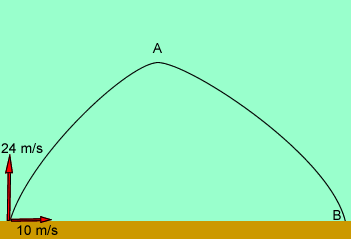Click to hide the solution
|
A ball is thrown skywards with an initial vertical velocity of 24 m/s and an initial horizontal velocity of 10 m/s as shown on the right. Ignore air resistance
|
 |
|
a) What is the initial velocity
of the ball? |
|
|
b) How long does the ball take to reach its maximum height? Assuming g =10 m/s/s/. Don't forget that the
horizontal and vertical velocities are independent. Height is determined
by the vertical velocity. |
|
| c) What is the
maximum height reached by the ball? To answer this question we use our straight line motion formulae. Click to revise. Distance is given by the formula d = (1/2)at2 . Where d = distance, a =10 m/s/s/ and t = time. d = (1/2)10 (2.4)2 = 28.8 m |
|
|
d) How far does the ball
land from the thrower? |
|
| e) What is the
magnitude of the velocity of the ball at "A"? At the top of its path vertical velocity has shrunk to zero while the horizontal velocity remains constant throughout the entire flight. The velocity is 10 m/s. |
|
|
Click
to hide the solution
|
|
